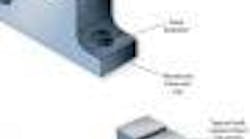Engineers often design carriages that move back and forth atop of a pair of parallel nonrotating shafts. These shafts must remain parallel or the carriage will wedge to a dead stop. So it is important that supports keep the shafts aligned. This can be a problem with traditional support blocks that keep the shaft locked into place with a cap screw located above and perpendicular to the shaft. With tradtional blocks, the shaft has to be inserted through the hole, a task that requires extra space on either end of the support. When the shafts, bushings, bearings, or carriage need maintenance, the shaft-support blocks must be removed and the alignment is lost. After servicing, the shaft has to be reinserted and the supports realigned, a time-consuming process
To simplify this process, engineers at Ondrives US Corp., Freeport, N. Y. (www.ondrivesus.com), developed a shaft support with a removable top. It lets users remove shafts, as well as the linear bushings and carriage, without upsetting the position of the shaft supports. This eliminates the need to realign the supports after maintenance. It also gives technicians easier access to shafts in locations with limited space on either end of the shafts.The supports are made of anodized aluminum, making them similar in strength but 70% lighter than cast-iron shaft supports. They are available for shafts ranging in diameter from 0.25 to 2.0 in. The company makes a "standard" range of supports that have the same shaft height and mounting footprint as the most popular industry-standard supports. They also offer a line of low-profile supports that provide the lowest possible carriage heights.

